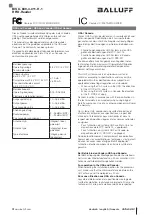
Chapter 7
Counters
©
National Instruments Corporation
7-15
80 MHz Timebase. Your measurement may return 1600 ±1 cycles
depending on the phase of the signal with respect to the timebase. As
your frequency becomes larger, this error of ±1 cycle becomes more
significant; Table 7-1 illustrates this point.
•
Method 1b (measuring K periods of F1) improves the accuracy of the
measurement. A disadvantage of Method 1b is that you have to take
K + 1 measurements. These measurements take more time and
consume some of the available PCI or PXI bandwidth.
•
Method 2 is accurate for high frequency signals. However, the
accuracy decreases as the frequency of the signal to measure
decreases. At very low frequencies, Method 2 may be too inaccurate
for your application. Another disadvantage of Method 2 is that it
requires two counters (if you cannot provide an external signal of
known width). An advantage of Method 2 is that the measurement
completes in a known amount of time.
•
Method 3 measures high and low frequency signals accurately.
However, it requires two counters.
Table 7-2 summarizes some of the differences in methods of measuring
frequency.
Table 7-1.
Frequency Measurement Method 1
Task
Equation
Example 1
Example 2
Actual Frequency to Measure
F1
50 kHz
5 MHz
Timebase Frequency
Ft
80 MHz
80 MHz
Actual Number of Timebase
Periods
Ft/F1
1600
16
Worst Case Measured Number of
Timebase Periods
(Ft/F1) – 1
1599
15
Measured Frequency
Ft F1/(Ft – F1)
50.125 kHz
5.33 MHz
Error
[Ft F1/(Ft – F1)] – F1
125 kHz
333 kHz
Error %
[Ft/(Ft – F1)] – 1
0.06%
6.67%
Summary of Contents for PCI-6238
Page 1: ...PCI 6238...
















































